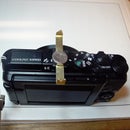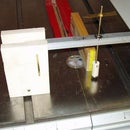Introduction: Add In-line Outlets to 110v Appliance Power Cord.
Seems there will be no end to the devices we add to our TV. Some are optional, but recently our cable company told us we had to add a converter to get digital broadcast. So I need to plug the converter power supply somewhere. The wall outlet is full, so I could add a power strip, but do not want to. And my wife wants it to look good, so that is the real motivation. Don't want it to look like this intro photo.
I decided to add in-line outlets to the existing TV power cord. That is what this Instructable describes.
NO, the intro photo does not show what we have in our house, but it does make a point.
I decided to add in-line outlets to the existing TV power cord. That is what this Instructable describes.
NO, the intro photo does not show what we have in our house, but it does make a point.
Step 1: Buy the End-of-line Outlet Type Connector.
I thought there would be a clip-on type outlet I could buy for in-line application, but could not find any at the hardware stores. There are plenty of end-of-cord outlets, but none for adding in-line to an existing appliance cord. OK, they may exist somewhere, but I gave up looking and decided to make one myself.
There are many of these, meant to just clip over the end of a standard 18 gauge double strand cord. You lay the cord into a groove in the outlet, then clamp the connector closed; there are prongs that penetrate the cords to make the connections.
I bought one, thinking I could modify it to meet my needs.
There are many of these, meant to just clip over the end of a standard 18 gauge double strand cord. You lay the cord into a groove in the outlet, then clamp the connector closed; there are prongs that penetrate the cords to make the connections.
I bought one, thinking I could modify it to meet my needs.
Step 2: Modify Outlet for In-line Use
The outlet I bought was only for end-of-cord use, there was no way for the cord to continue through the outlet.
I created an opening for the cord to pass through by cutting away a portion of the hinge. Photos here show before and after.
Step 3: Insert Cord Through Outlet and Clamp Closed
Now, with the outlet modified, it can be assembled around the cord, with the cord continuing to the TV. You can see in the photo where I had to enlarge the opening for the cord, it was a bit larger than standard light cord and was a snug fit.
The outlet can now be closed, with the metal prongs piercing the electrical cord.
A few words of caution: When making heavy duty extension cords, I avoid this type of outlet that just pierces the wires to make the electrical connection. I prefer the industrial type with screw terminals. But in this case the load is light, and all seems OK. But use caution, as with all electrical work, and test it before putting it into service.
The outlet can now be closed, with the metal prongs piercing the electrical cord.
A few words of caution: When making heavy duty extension cords, I avoid this type of outlet that just pierces the wires to make the electrical connection. I prefer the industrial type with screw terminals. But in this case the load is light, and all seems OK. But use caution, as with all electrical work, and test it before putting it into service.
Step 4: Clamp It Tight.
The TV cord is heavier than a standard light cord, so I used a woodworking clamp to make sure the prongs really penetrate and make a good connection.
Step 5: Taped, Tested, and Done.
The store bought outlet had a metal clip which kept it closed, but the clip was lost during modification. So you will notice in the photo a liberal use of tightly wound electrical tape. But it is brown tape to match the outlet; never mind that the outlet color does not match the cord, alas. And it will be hidden behind the TV. The new digital adapter from the cable company will plug in here, with room for another gadget.
Gee, 124.5 volts AC.
Gee, 124.5 volts AC.











